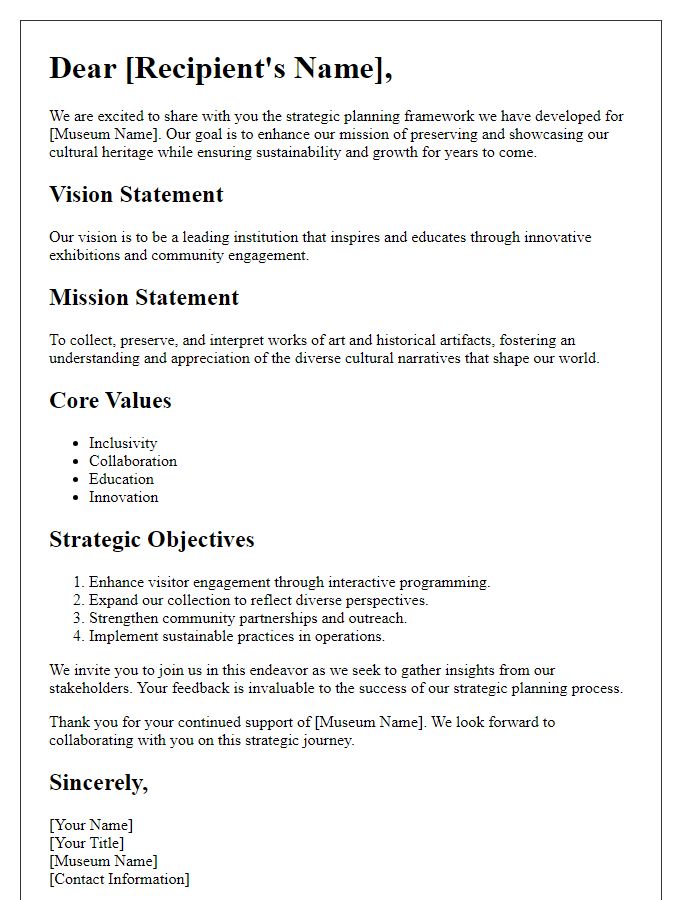In the ever-evolving landscape of museums, crafting a strategic vision is essential for fostering engagement and preserving our cultural heritage. This letter outlines a comprehensive framework designed to elevate our institution's mission and connection with the community. By focusing on innovation, inclusivity, and sustainability, we aim to create a captivating experience for every visitor who walks through our doors. Join us as we delve deeper into this vision and explore the exciting initiatives that lie ahead!

Mission Statement
A mission statement for a museum should encapsulate its purpose, values, and goals while reflecting its commitment to education, preservation, and community engagement. For instance, the Natural History Museum in London emphasizes its dedication to advancing knowledge about the natural world through innovative exhibitions, engaging public programs, and robust research efforts. The mission could state objectives such as providing accessible and inclusive opportunities for visitors to explore biodiversity, fostering curiosity in the sciences, and inspiring conservation efforts that protect ecosystems globally. Additionally, the museum seeks to collaborate with local schools and communities, engaging diverse audiences and promoting lifelong learning in the context of cultural and natural heritage.
Core Values
Core values form the foundation of a museum's strategic vision, guiding decisions and actions. Inclusivity ensures diverse voices and perspectives are represented in exhibitions and programs. Educational excellence prioritizes meaningful learning experiences, engaging visitors with interactive displays. Sustainability emphasizes environmentally responsible practices in curation and operations, promoting stewardship of cultural and natural heritage. Community engagement encourages partnerships with local organizations and residents, fostering a sense of belonging and shared ownership. Innovation drives the adoption of new technologies and creative approaches, enhancing visitor experiences and outreach efforts. Respect for collections preserves the integrity of artifacts, maintaining their cultural significance for future generations. These core values collectively shape a museum that is relevant, accessible, and impactful within its community.
Target Audience
A well-defined target audience is crucial for shaping the strategic vision of a museum, influencing programming, exhibits, and outreach efforts. Key demographic groups may include local families seeking educational experiences, school groups pursuing curriculum-aligned field trips, art enthusiasts drawn to contemporary and historical works, and tourists eager to explore unique cultural attractions in cities like New York or Paris. Additionally, diverse audiences such as underrepresented communities and special interest groups can be engaged through tailored programs and accessible exhibits. Understanding their interests, behaviors, and preferences can help develop targeted marketing campaigns and enhance visitor engagement, ensuring that the museum's mission resonates with a broad spectrum of the community.
Key Objectives
A strategic vision for a museum outlines key objectives that guide its growth and development. Enhancing community engagement is crucial, aiming to increase visitor numbers by 30% over the next five years through outreach programs and partnerships with local schools. Expanding the collection by acquiring significant artifacts, such as a rare 19th-century painting valued at over $1 million, is a priority to enrich the museum's offerings. Implementing advanced technology, like interactive digital displays and augmented reality exhibits, aims to improve visitor experience and education, targeting a 25% increase in educational program participation. Strengthening financial sustainability through diversified funding sources, including grants and corporate sponsorships, is essential for long-term success. Finally, improving facility accessibility, including wheelchair access and sensory-friendly spaces, ensures inclusivity and broadens its audience reach.
Strategic Initiatives
Strategic initiatives drive the growth and effectiveness of cultural institutions, such as museums. These initiatives should focus on enhancing visitor engagement through immersive experiences, leveraging technology, and expanding educational programs that align with contemporary issues. Partnerships with local communities in urban areas, like San Francisco or New York, can create outreach opportunities that foster inclusivity. Implementing virtual reality exhibitions allows for broader access beyond physical limitations, engaging remote audiences. Strengthening sustainability practices ensures the conservation of artifacts while promoting eco-friendly operations. Regular evaluation and adaptation of these strategies can enhance organizational resilience in a rapidly changing cultural landscape.













Comments